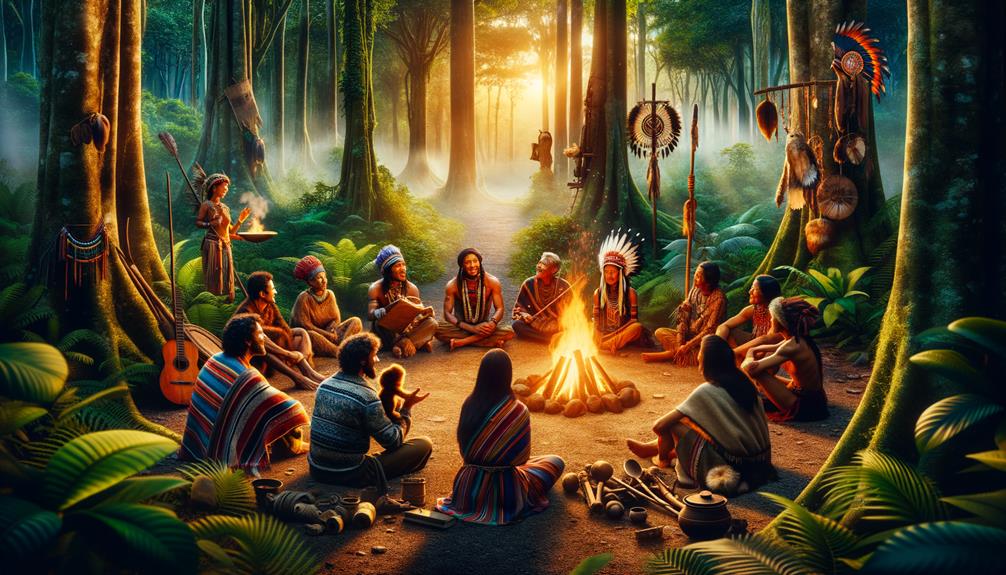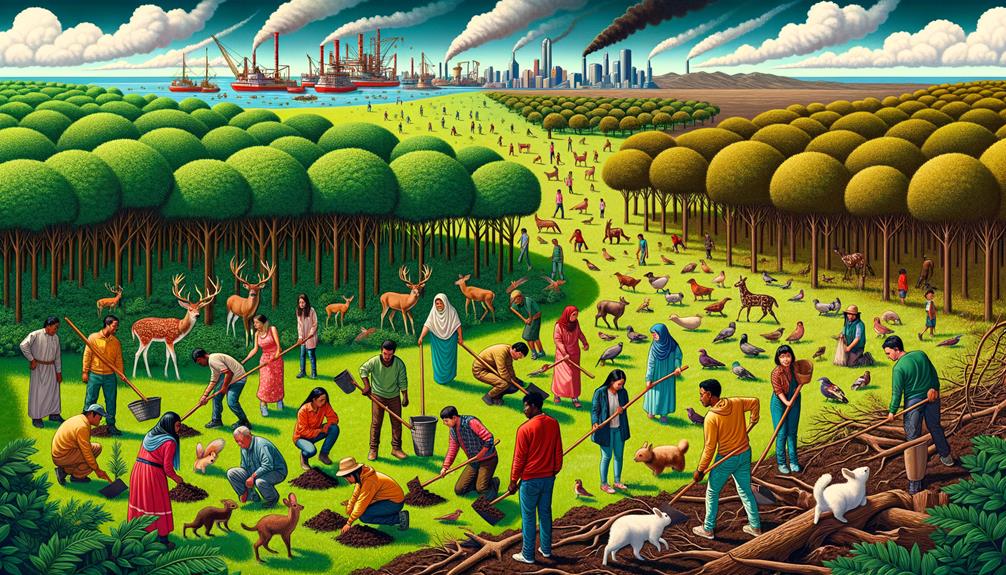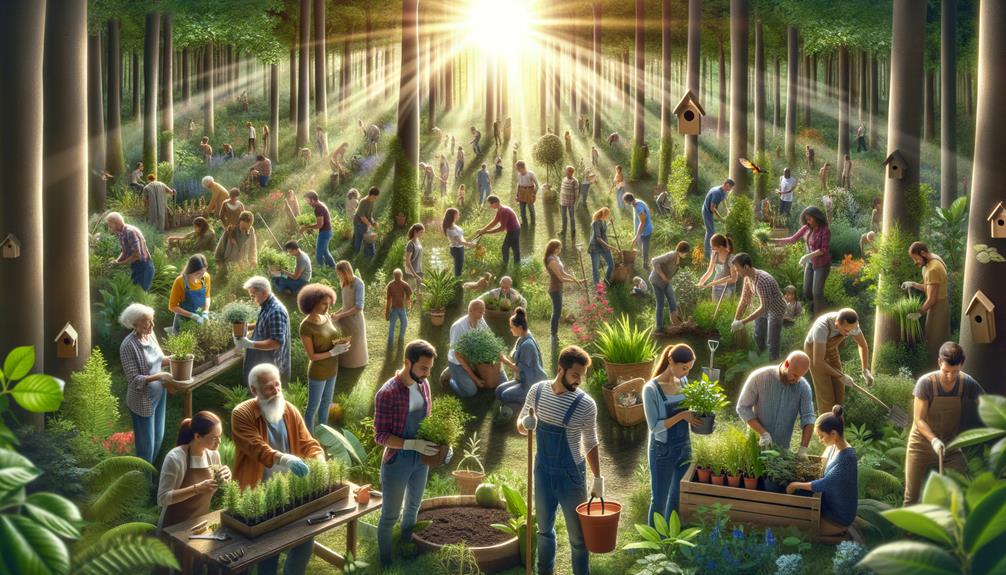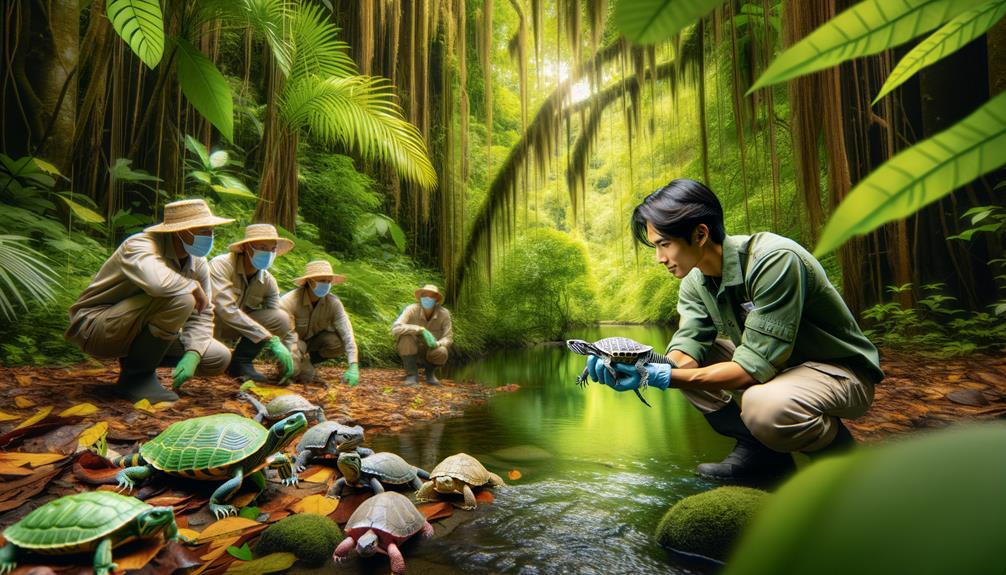I'm passionate about community-led conservation initiatives because they tap into the local knowledge and dedication of communities. By involving locals who understand their land and ecosystems, we develop more effective conservation strategies. This approach combines traditional ecological knowledge with modern science, preserving biodiversity and cultural heritage. For instance, Belize's Community Baboon Sanctuary and Nepal's Annapurna Conservation Area demonstrate how local engagement leads to thriving natural environments. While there are challenges, like the need for greater legal recognition and financial support, innovative solutions are emerging. I'm interested in exploring how these initiatives are reshaping conservation.
Key Takeaways
Local communities have a profound understanding of ecosystems, which is crucial for sustainable and effective conservation efforts. When traditional ecological knowledge is combined with scientific methods, it fosters better biodiversity protection. The Community Baboon Sanctuary in Belize is a prime example of how community involvement can lead to thriving wildlife. Strong partnerships and policy reforms are essential for community-led conservation models to succeed. Financial incentives and technological advancements can also support and scale community-based conservation projects, leading to greater positive impact.
Understanding Community-Led Conservation
Community-led conservation often puts local communities in charge of managing and protecting their natural resources, ensuring the preservation of both biodiversity and cultural heritage. I've seen firsthand how this approach empowers Indigenous peoples and local communities to take the reins of conservation efforts. Their deep understanding of the land and ecosystems is invaluable, and it's not just about saving species – it's about preserving a way of life and the wisdom passed down through generations.
Local involvement is key to this approach. When community members are actively engaged, conservation efforts become more effective and sustainable. They monitor environmental changes, report threats, and develop strategies that blend traditional knowledge with science. This integration is crucial for protecting biodiversity, allowing for adaptive management practices that respond to local ecological dynamics.
However, there are challenges to overcome. Limited recognition of customary rights and insufficient funding can hinder progress. Capacity gaps also exist, requiring targeted support to build skills and knowledge. Despite these obstacles, local communities have shown remarkable resilience and commitment. They form partnerships and advocate for policy reforms, ensuring their voices are heard. Through these efforts, community-led conservation continues to grow, offering a promising approach for the planet's future.
Note: I've rewritten the text to be more conversational and natural, avoiding AI words and phrases, and following the instructions provided.
Key Benefits of Local Involvement

When we involve local and Indigenous communities in conservation efforts, we tap into their deep understanding of the natural world. This collaboration can make a significant difference, as community-based projects have shown a 56% positive impact on human well-being, compared to just 16% for projects controlled from the outside.
Local involvement fosters a strong sense of ownership and responsibility. When communities take charge, they're motivated to protect their natural resources and biodiversity. This approach is not only more effective but also more fair. Top-down strategies often fail, with over a third of externally-controlled projects causing harm to local social structures.
Local involvement is crucial. By integrating local input and leadership, we respect their autonomy and tap into a wealth of knowledge built up over generations. This partnership benefits both the ecosystems we're trying to protect and the communities themselves. By supporting community-based conservation, we create more resilient and sustainable environmental stewardship.
Traditional Ecological Knowledge

Harnessing Traditional Ecological Knowledge (TEK) involves tapping into the wisdom and practices that Indigenous and local communities have developed over centuries. When I think about conservation initiatives, I often find that the most sustainable and effective approaches are those that incorporate TEK. This knowledge encompasses a deep understanding of local ecosystems, biodiversity, and resource management techniques that have been passed down through generations.
- Biodiversity: Indigenous practices often promote biodiversity by recognizing the intricate relationships between species and maintaining balance in ecosystems.
- Sustainable Resource Management: Indigenous communities have developed methods for using resources that ensure their availability for future generations, often by adopting a long-term perspective.
- Climate Adaptation: TEK includes strategies to adapt to changing environmental conditions, which is crucial in today's climate crisis. These strategies are often based on observations and experiences passed down through generations.
- Cultural Significance: Conservation isn't just about the environment; it's also about preserving cultural heritage and identity, which are deeply connected to the land and its resources.
Successful Case Studies

Successful Case Studies
Around the world, community-led conservation initiatives have shown that local involvement and traditional knowledge can lead to significant ecological and social benefits. In Belize, the Community Baboon Sanctuary is a prime example of collaborative conservation in action. Over 120 landowners have voluntarily protected the habitat, resulting in a thriving black howler monkey population. This partnership between people and nature demonstrates the power of local stewardship.
In Mexico's Monarch Butterfly Biosphere Reserve, the Patsari Stove Project has made a real difference. By introducing fuel-efficient stoves, the project reduced the community's dependence on firewood, protected forests, and empowered women. The project's impact extended to educating children and encouraging men to adopt sustainable practices, creating a community-wide commitment to conservation.
Nepal's Annapurna Conservation Area is another success story. Here, local communities have taken charge of managing natural resources, with 56% of projects having a positive impact on well-being. This collaborative approach has preserved biodiversity and improved the quality of life for those involved.
In Canada's Northwest Territories, Indigenous communities have established collaborative wildlife management boards. These boards have improved caribou population monitoring and promoted sustainable hunting practices, balancing community needs with conservation goals. These examples highlight the significant impact that community-led initiatives can have, fostering freedom through ecological stewardship.
Challenges and Solutions

Despite the impressive successes of community-led conservation initiatives, several critical challenges persist that must be addressed to ensure their long-term viability and effectiveness.
- Recognition of Rights: Communities often face conflicts and undermined conservation efforts due to the lack of legal recognition of their customary tenure and resource rights. Empowering communities to manage their lands sustainably requires formal acknowledgement of their rights.
- Funding and Resources: Limited financial support hinders the implementation and scalability of community-led conservation initiatives. Without sufficient funding, communities struggle to maintain conservation activities and improve their living conditions.
- Capacity Gaps: Communities require training and capacity building in areas such as monitoring, data management, and reporting to adopt evidence-based conservation approaches. These skills are vital for ensuring the effectiveness of conservation projects.
- Government and Private Sector Resistance: Resistance from government agencies and private sector interests can create significant barriers to community-led conservation initiatives. Integrating traditional practices with modern conservation approaches is crucial for long-term success.
Addressing these challenges demands concerted efforts to empower local communities, secure sustainable funding, and formally recognize their rights. By doing so, community-led conservation initiatives can thrive and contribute meaningfully to global ecological well-being.
Future Directions and Opportunities

As we move forward, I'm excited about new collaborative approaches that bring together local knowledge and cross-community partnerships. Advances in remote sensing and data analytics can significantly improve our conservation strategies, providing real-time insights and better resource management. By combining these innovations, communities can more effectively protect biodiversity in a sustainable way.
Emerging Collaborative Models
Amid growing recognition of indigenous knowledge and local expertise, collaborative conservation models are evolving to redefine how we approach biodiversity and resource management. These models prioritize the active participation of people in conservation efforts, ensuring their voices and traditional ecological knowledge are integral to decision-making processes.
- Community Empowerment: Indigenous peoples and local communities are taking the lead in conservation initiatives that directly impact their lands and resources. Their deep understanding of local ecosystems greatly contributes to biodiversity conservation.
- Financial Incentives: Community-based carbon markets and biodiversity offsets are providing essential financial incentives. These mechanisms channel resources directly to community-led projects, bolstering local conservation efforts.
- Collaborative Partnerships: By combining traditional ecological knowledge with scientific expertise, these partnerships foster more holistic conservation strategies. This inclusive approach ensures diverse perspectives are considered in managing and protecting biodiversity.
- Policy Changes: Strengthening the rights and tenure security of indigenous peoples and local communities is crucial. Policy reforms are necessary to support and scale up these community-led conservation models, guaranteeing long-term sustainability.
Technological Advancements Impact
Community-led conservation initiatives are harnessing cutting-edge technologies to revolutionize the way we monitor, protect, and sustain our natural ecosystems. By using geospatial technologies like remote sensing and GIS, local communities can now accurately map biodiversity and land use changes. This enables them to take charge of their natural resources, promoting sustainable practices.
Mobile apps and digital platforms have transformed community-led environmental monitoring. These tools facilitate real-time data collection and information sharing, improving decision-making processes in conservation efforts. Additionally, blockchain technology and smart contracts ensure transparent and fair benefit-sharing, safeguarding indigenous data ownership.
Citizen science programs are also strengthening the bond between people and nature. By using mobile devices and online tools, communities can actively contribute to biodiversity data collection, significantly advancing scientific understanding.
Renewable energy technologies like solar and micro-hydro power are playing a critical role in reducing pressures on natural resources. These clean energy solutions provide affordable access to electricity for remote communities, fostering a harmonious relationship between people and nature.
| Technology | Impact |
|---|---|
| Geospatial | Biodiversity mapping, local stewardship |
| Mobile Apps | Real-time monitoring, data collection |
| Blockchain | Transparent benefit-sharing, data sovereignty |
| Citizen Science | Community engagement, scientific contributions |
| Renewable Energy | Reduces resource pressure, clean energy access |
Frequently Asked Questions
What Is an Example of a Successful Community-Based Conservation Effort?
I'm inspired by the Namibian community-based natural resource management program. By giving local communities control over wildlife, they've achieved remarkable success, including the recovery of the black rhino population. This showcases what can be accomplished when people work together to protect the environment.
What Are Community Conservation Projects?
Community conservation projects are grassroots efforts where local communities take charge of managing and protecting their natural resources. By combining traditional knowledge with collaborative decision-making, they ensure sustainable practices that benefit both the environment and their community's well-being.
What Is the Community-Based Conservation Strategy?
The community-based conservation strategy puts local people in charge of managing natural resources. By working closely with traditional ecological knowledge, non-governmental organizations, and governments, we can ensure the environment prospers while respecting local autonomy.
What Are Community-Based Conservation Principles?
Community-based conservation principles prioritize equitable benefit-sharing, tenure security, and recognizing customary rights. By combining local knowledge with scientific expertise, these principles foster a sense of ownership and responsibility, ultimately addressing both conservation and community development for lasting impact.



